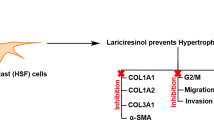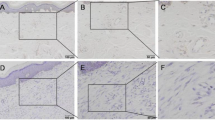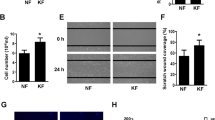Abstract
Asiaticoside (ATS) isolated from the leaves of Centella asiatica possesses strong wound-healing properties and reduces scar formation. However, the specific effects of asiaticoside on the formation of keloidal scars remain unknown. In the present study, we evaluated the in vitro effects of asiaticoside on the proliferation, collagen expression, and transforming growth factor (TGF)-β/Smad signaling of keloid-derived fibroblasts. Fibroblasts isolated from keloid tissue and normal skin tissues were treated with asiaticoside at different concentrations. Afterwards, they were subjected to RT-PCR and Western blot analyses. The inhibitory effects of asiaticoside on fibroblast viability were assayed using the 3-(4,5-dimethylthiazol-2-yl)-2,5-diphenyltetrazolium bromide (MTT) assay. Asiaticoside decreased fibroblast proliferation in a time- and dose-dependent manner. It also inhibited type I and type III collagen protein and mRNA expressions. In addition, asiaticoside reduced the expression of both TGF-βRI and TGF-βRII at the transcriptional and translational level. Moreover, it increased the expression of Smad7 protein and mRNA. However, asiaticoside did not influence the expression of Smad2, Smad3, Smad4, phosphorylated Smad2, and phosphorylated Smad3. Taken together, these results suggest that asiaticoside could be of potential use in the treatment and/or prevention of hypertrophic scars and keloids.





Similar content being viewed by others
References
Chen SJ, Yuan W, Lo S, Trojanowska M, Varga J (2000) Interaction of smad3 with a proximal smad-binding element of the human alpha2(I) procollagen gene promoter required for transcriptional activation by TGF-beta. J Cell Physiol 183:381–392
Chen SJ, Yuan W, Mori Y, Levenson A, Trojanowska M, Varga J (1999) Stimulation of type I collagen transcription in human skin fibroblasts by TGF-beta: involvement of Smad 3. J Invest Dermatol 112:49–57
Cheng CL, Guo JS, Luk J, Koo MWL (2004) The healing effects of Centella extract and asiaticoside on acetic acid induced gastric ulcers in rats. Life Sci 74:2237–2249
Chin GS, Liu W, Peled Z, Lee TY, Steinbrech DS, Hsu M, Longaker MT (2001) Differential expression of transforming growth factor-beta receptors I and II and activation of Smad 3 in keloid fibroblasts. Plast Reconstr Surg 108:423–429
Derynck R, Zhang YE (2003) Smad-dependent and Smad-independent pathways in TGF-beta family signalling. Nature 425:577–584
Dienus K, Bayat A, Gilmore BF, Seifert O (2010) Increased expression of fibroblast activation protein-alpha in keloid fibroblasts: implications for development of a novel treatment option. Arch Dermatol Res 302(10):725–731
Dong MS, Jung SH, Kim HJ, Kim JR, Zhao LX, Lee ES, Lee EJ, Yi JB, Lee N, Cho YB, Kwak WJ, Park YI (2004) Structure-related cytotoxicity and anti-hepatofibric effect of asiatic acid derivatives in rat hepatic stellate cell-line, HSC-T6. Arch Pharm Res 27:512–517
Dooley S, Hamzavi J, Breitkopf K, Wiercinska E, Said HM, Lorenzen J, Ten Dijke P, Gressner AM (2003) Smad7 prevents activation of hepatic stellate cells and liver fibrosis in rats. Gastroenterology 125:178–191
Goumans MJ, Mummery C (2000) Functional analysis of the TGFbeta receptor/Smad pathway through gene ablation in mice. Int J Dev Biol 44:253–265
Gressner AM, Weiskirchen R (2003) The tightrope of therapeutic suppression of active transforming growth factor-beta: high enough to fall deeply? J Hepatol 39:856–859
Guo JS, Cheng CL, Koo MWL (2004) Inhibitory effects of Centella asiatica water extract and asiaticoside on inducible nitric oxide synthase during gastric ulcer healing in rats. Planta Med 70:1150–1154
Hayashi H, Abdollah S, Qiu Y, Cai J, Xu YY, Grinnell BW, Richardson MA, Topper JN, Gimbrone MA, Wrana JL et al (1997) The MAD-related protein Smad7 associates with the TGFbeta receptor and functions as an antagonist of TGFbeta signaling. Cell 89:1165–1173
Hsu YC, Chen MJ, Yu YM, Ko SY, Chang CC (2010) Suppression of TGF-β1/SMAD pathway and extracellular matrix production in primary keloid fibroblasts by curcuminoids: its potential therapeutic use in the chemoprevention of keloid. Arch Dermatol Res 302(10):717–724
Huang Y-H, Zhang S-H, Zhen R-X, Xu X-D, Zhen Y-S (2004) Asiaticoside inducing apoptosis of tumor cells and enhancing anti-tumor activity of vincristine. Ai Zheng 23:1599–1604
Kimura Y, Sumiyoshi M, Samukawa K-I, Satake N, Sakanaka M (2008) Facilitating action of asiaticoside at low doses on burn wound repair and its mechanism. Eur J Pharmacol 584:415–423
Kolb M, Margetts PJ, Sime PJ, Gauldie J (2001) Proteoglycans decorin and biglycan differentially modulate TGF-beta-mediated fibrotic responses in the lung. Am J Physiol Lung Cell Mol Physiol 280:L1327–L1334
Kopp J, Preis E, Said H, Hafemann B, Wickert L, Gressner AM, Pallua N, Dooley S (2005) Abrogation of transforming growth factor-beta signaling by SMAD7 inhibits collagen gel contraction of human dermal fibroblasts. J Biol Chem 280:21570–21576
Kryger ZB, Sisco M, Roy NK, Lu L, Rosenberg D, Mustoe TA (2007) Temporal expression of the transforming growth factor-Beta pathway in the rabbit ear model of wound healing and scarring. J Am Coll Surg 205:78–88
Leask A, Abraham DJ (2004) TGF-beta signaling and the fibrotic response. FASEB J 18:816–827
Lee YS, Jin D-Q, Kwon EJ, Park SH, Lee E-S, Jeong TC, Nam DH, Huh K, Kim J-A (2002) Asiatic acid, a triterpene, induces apoptosis through intracellular Ca2+ release and enhanced expression of p53 in HepG2 human hepatoma cells. Cancer Lett 186:83–91
Liu W, Wang DR, Cao YL (2004) TGF-beta: a fibrotic factor in wound scarring and a potential target for anti-scarring gene therapy. Curr Gene Ther 4:123–136
Lu L, Saulis AS, Liu WR, Roy NK, Chao JD, Ledbetter S, Mustoe TA (2005) The temporal effects of anti-TGF-β1, 2, and 3 monoclonal antibody on wound healing and hypertrophic scar formation. J Am Coll Surg 201:391–397
Luo S, Benathan M, Raffoul W, Panizzon RG, Egloff DV (2001) Abnormal balance between proliferation and apoptotic cell death in fibroblasts derived from keloid lesions. Plast Reconstr Surg 107:87–96
Maquart FX, Chastang F, Simeon A, Birembaut P, Gillery P, Wegrowski Y (1999) Triterpenes from Centella asiatica stimulate extracellular matrix accumulation in rat experimental wounds. Eur J Dermatol 9:289–296
Mook-Jung I, Shin JE, Yun SH, Huh K, Koh JY, Park HK, Jew SS, Jung MW (1999) Protective effects of asiaticoside derivatives against beta-amyloid neurotoxicity. J Neurosci Res 58:417–425
Mukhopadhyay A, Khoo A, Cheong HH, Chan SY, Aalami O, Lim IJ, Phan TT (2007) Targeting of Sp1 transcription factor: a novel therapeutic approach for keloids, an in vitro analysis. Exp Dermatol 16:1023–1031
Seifert O, Mrowietz U (2009) Keloid scarring: bench and bedside. Arch Dermatol Res 301(4):259–272
Shih B, Bayat A (2010) Genetics of keloid scarring. Arch Dermatol Res 302(5):319–339
Terada Y, Hanada S, Nakao A, Kuwahara M, Sasaki S, Marumo F (2002) Gene transfer of Smad7 using electroporation of adenovirus prevents renal fibrosis in post-obstructed kidney. Kidney Int 61:S94–S98
Verrecchia F, Mauviel A (2002) Transforming growth factor-beta signaling through the Smad pathway: role in extracellular matrix gene expression and regulation. J Invest Dermatol 118:211–215
Wolfram D, Tzankov A, Pülzl P, Piza-Katzer H (2009) Hypertrophic scars and keloids—a review of their pathophysiology, risk factors, and therapeutic management. Dermatol Surg 35:171–181
Yu H, Bock O, Bayat A, Ferguson MWJ, Mrowietz U (2006) Decreased expression of inhibitory SMAD6 and SMAD7 in keloid scarring. J Plast Reconstr Aesthet Surg 59:221–229
Yun K-J, Kim J-Y, Kim J-B, Lee K-W, Jeong S-Y, Park H-J, Jung H-J, Cho Y-W, Yun K, Lee K-T (2008) Inhibition of LPS-induced NO and PGE2 production by asiatic acid via NF-kappa B inactivation in RAW 264.7 macrophages: possible involvement of the IKK and MAPK pathways. Int Immunopharmacol 8:431–441
Acknowledgments
This work was supported by National Natural Science Foundation of China Grants 30973128; Natural Science Foundation of Guangdong Province Grants 7001657 and 8151008901000082; Medical Science Research Foundation of Guangdong Province Grants B2007042.
Author information
Authors and Affiliations
Corresponding author
Rights and permissions
About this article
Cite this article
Tang, B., Zhu, B., Liang, Y. et al. Asiaticoside suppresses collagen expression and TGF-β/Smad signaling through inducing Smad7 and inhibiting TGF-βRI and TGF-βRII in keloid fibroblasts. Arch Dermatol Res 303, 563–572 (2011). https://doi.org/10.1007/s00403-010-1114-8
Received:
Revised:
Accepted:
Published:
Issue Date:
DOI: https://doi.org/10.1007/s00403-010-1114-8




